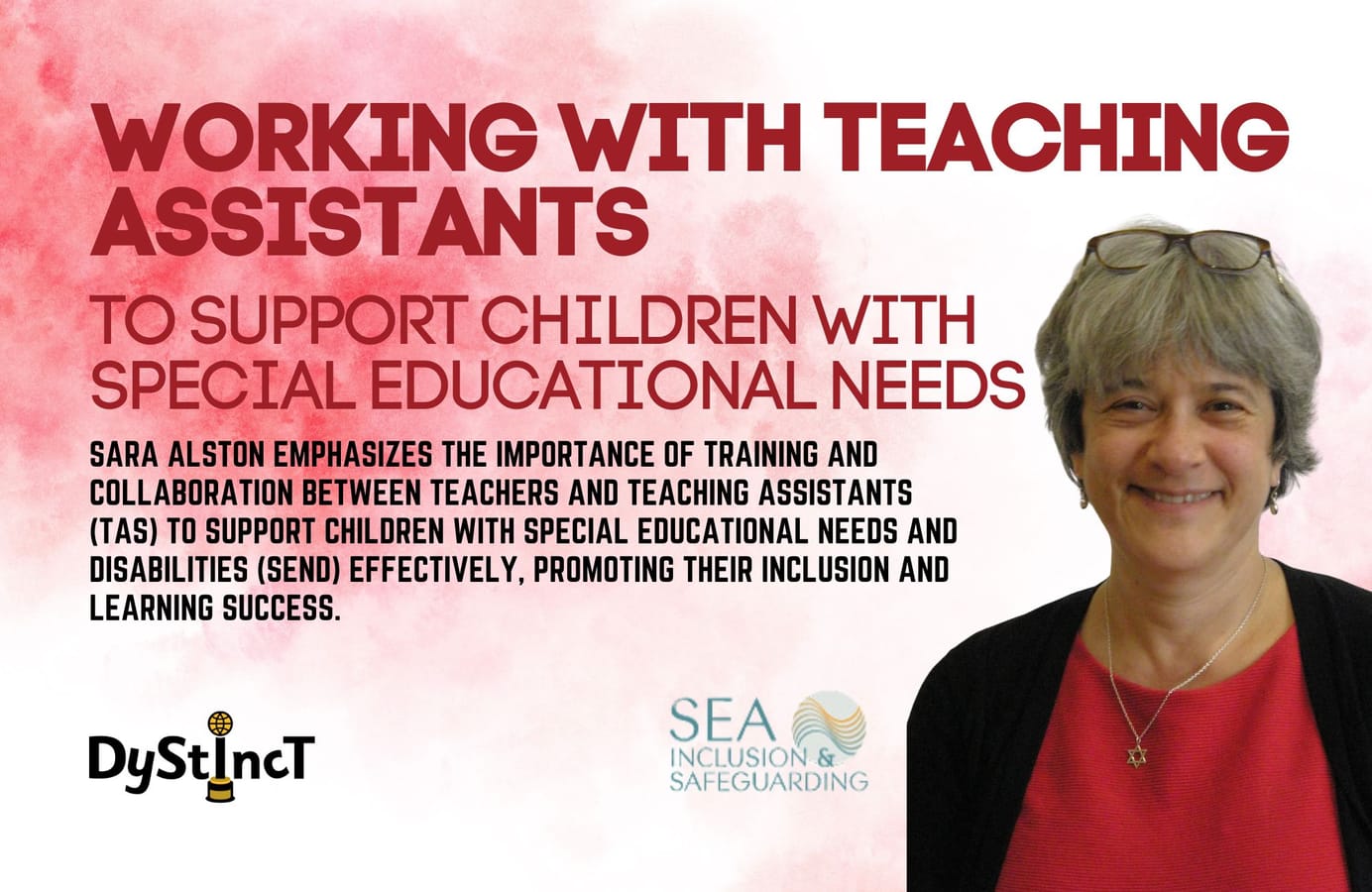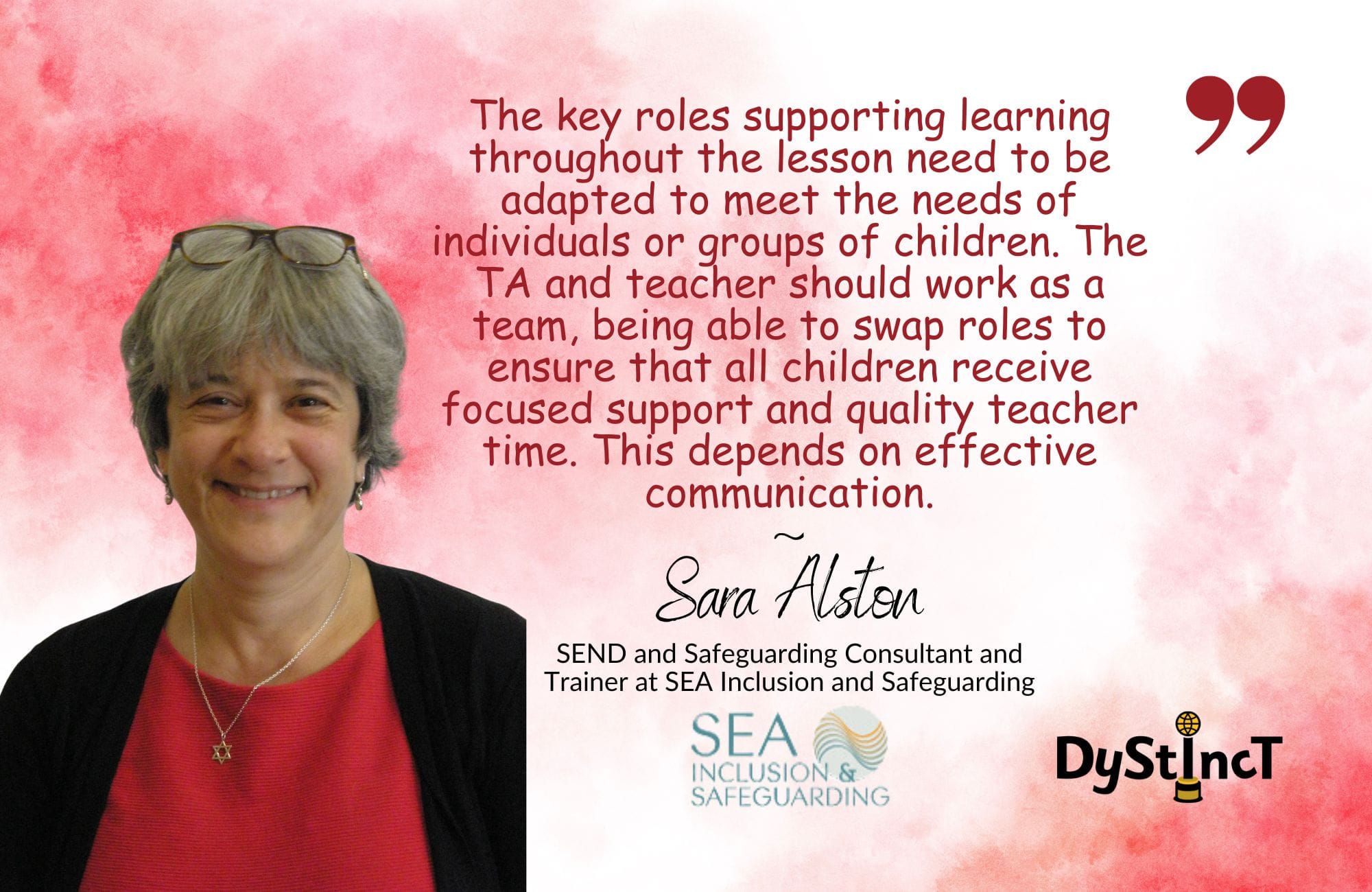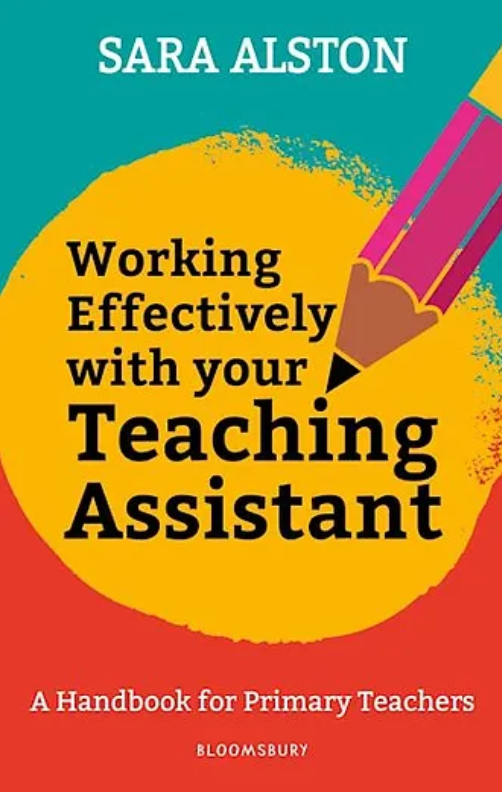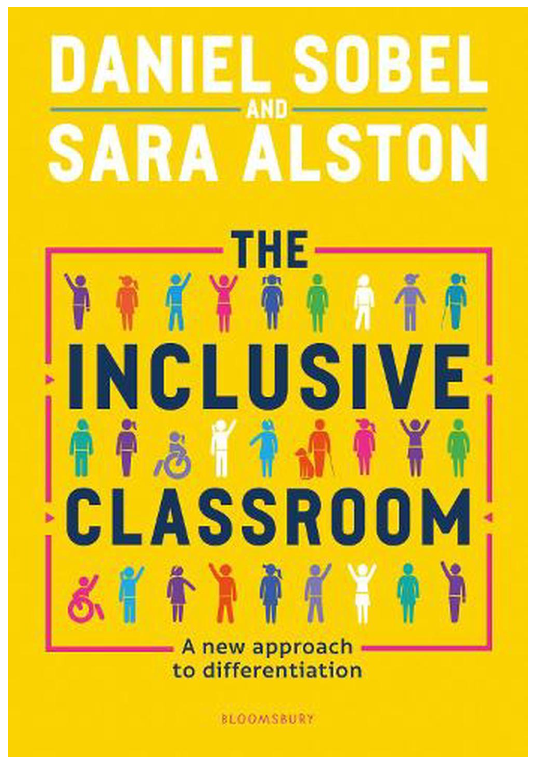
Issue 19: Working with Teaching Assistants to support children with Special educational needs | Sara Alston
Sara Alston emphasizes the importance of training and collaboration between teachers and Teaching Assistants (TAs) to support children with Special Educational Needs and Disabilities (SEND) effectively, promoting their inclusion and learning success.
Table of Contents
In many schools, when a child has SEND (Special Educational Needs and Disabilities) and needs support to access learning or make progress, the default response is support from an additional adult. This additional adult is almost always a TA (teaching assistant)- a paraprofessional. While many TAs are excellent and experienced practitioners, they are rarely qualified teachers.
There is a real danger in this approach leading to the education of our most vulnerable children being, to a greater or lesser extent, ‘outsourced’ to a less qualified adult. It is often a TA who implements interventions, provides differentiation, and adapts learning tasks, supporting the child to access learning within the classroom.
Unfortunately, few TAs receive any training beyond experience ‘on the job’. They are often poorly paid, leading to recruitment and retention problems. Further, their hours are often little more than the time when the children they are supporting are in school, so they have limited time to liaise with their teaching colleagues. Few of us do our best work when we do not fully understand what we are doing, yet this is the situation many TAs find themselves in on a daily basis.
Further, there is little training and few resources for classroom teachers on how to manage and work effectively with the additional adults in their classrooms. My book, Working Effectively with your Teaching Assistant (Bloomsbury, 2023), considers how to support effective communication between teachers and TAs so that they are able to work as a team to support children.
Developing a shared understanding of the roles of the teacher and TA throughout the lesson
Developing a shared understanding of the roles of the teacher and TA throughout the lesson
In our book, The Inclusive Classroom (Bloomsbury, 2021), Daniel Sobel and I focus on the importance of using small tweaks and adaptions to support inclusion throughout the five phases of the lesson. This is key to the effective deployment of TAs. Many strategies can be used throughout the lesson, others are focused within a particular phase of the lesson.
The effective use of visuals is fundamental to supporting the understanding of language, focus on learning and promoting access to instructions throughout the lesson. A TA using symbols and/ or pre-printed pictures for regular instructions (e.g. writing the date) and/ or a quick sketch on a whiteboard for less regular instruction makes them easier for children to understand, recall and follow.
Equally, visuals are critical to support vocabulary development, comprehension and processing, particularly for any child with language or communication difficulties. While some children can access visuals independently, many need an adult to direct them towards the prompt and/or explain it to them, particularly when it is first introduced.
Supporting children’s sensory needs is another area where TAs should promote learning throughout the lesson. Many children struggle to sit still. Fidgeting and fiddling may support their engagement and learning. While the use of ‘wobble cushions’, ‘kick bands’ and fidget objects may improve some children’s focus, many still need regular movement breaks. In an ideal world, children would manage and organise these independently. However, many, particularly younger children, need to be supervised when they leave the classroom and supported to engage in the exercises, they need to help calm and self-regulate.
Throughout the lesson, a proactive TA can act as an ‘extra pair of eyes’ and identify who is or is not accessing the learning. This may be through formal observations with an agreed focus, e.g. the use of a particular strategy or ongoing informal observations. However, to be valuable, this needs to be shared with the class teacher.
Visual timetables are extensively used to support children throughout the day, but many benefit from a visual or written plan of what to expect in a lesson. TA support to create a timetable or written list that can be ticked off or, crossed off or rubbed out when the activity is finished is often key to supporting children through a lesson as it reduces the unexpected and enables them to plan.
Phase One of the lesson: Transition, entering the classroom and preparing to learn.
Phase One of the lesson: Transition, entering the classroom and preparing to learn.
Unfortunately, many TAs will arrive with the children, making it difficult for them to support the transition into the room proactively. However, they can model explicitly the process of preparing to learn. Where possible, the TA can support the meet and greet for children. The process of saying ‘hello’ and making eye contact supports building effective relationships within the classroom and enables the adult to make a quick assessment of where children are and their readiness to learn. Some individuals need a personalised ‘meet and greet’, such as spending a few minutes with an adult, coming in earlier or later than their peers or completing a set activity, to feel safe in the classroom.
Phase Two: Delivering and receiving instructions and whole class engagement.
Phase Two: Delivering and receiving instructions and whole class engagement.
Too often, when TAs are going to provide additional or different support for children, they take them out of the delivery of instructions. This means that the child misses the instructions and modelling, so they start their independent work at a disadvantage.
Alternatively, a lack of preparedness means that the TA needs to listen to the teacher’s input to understand the new material that they will shortly be expected to teach and differentiate. Even in this situation, TAs can explicitly model learning, record ideas and information to support the children’s learning later. Supporting children to access instructions is vital if they are to be able to work independently at a later point in the lesson.
Equally, TAs have a key role in supporting children to respond to questioning. Oral rehearsal allows a child to ‘rehearse’ their response with an adult before sharing. By ‘rehearsing’ their ideas, we reduce children’s anxiety about making responses so that they are more able to focus and listen.
Phase Three: Individuals working as a class.
Phase Three: Individuals working as a class.
At this point, many TAs ‘take ownership’ of a group- often the less able or those with SEND and lead their learning. However, this can become a model of segregation where the most vulnerable learners are separated from their teacher.
There are alternative methods of TA deployment to replace the one-to-one TA who is Velcroed to the child’s side. For example, ‘helicopter’ support, where the TA provides a child with a prompted start, they then work independently before the TA returns and provides further support in a repeated cycle. This promotes the child’s independence and enables the TA to work with others.
Where a child struggles to start learning tasks, they may benefit from someone to revisit and clarify the instructions or an opportunity to share their understanding of the task. The adult can then model what the child needs to do, possibly completing the first calculation or planning sentences together so they don’t face a blank sheet. The child can then work independently.
Alternatively, support can be ‘flipped’ so the TA undertakes the roving role in the class while the teacher sits with an individual or group, scaffolding and breaking the task into short segments. Visual checklists, now and next cards and task management boards support children to identify and plot their way through tasks. Self-talk is an essential part of metacognition and is key to enabling children to identify the stages and structure of their learning. The provision of concrete resources and apparatus can prompt children’s learning. By scaffolding the task, asking what they need to do next and what they already know, an adult can move the child towards greater independence.
The key to children accessing learning is enabling them to focus on it. There is usually a considerable amount of admin involved, e.g. writing the date and title or sticking in worksheets before a child can start recording their learning. For many children, this admin can become overwhelming, so that they never access the learning. TAs can complete this so that children can focus on the learning.
Difficulties with reading and recording often inhibit children’s learning. Working towards children recording independently is a slow process, yet difficulties with recording should not be a barrier to children demonstrating their learning and understanding. Staff need to develop a mindset where they are willing and able to identify learning when it is not recorded in the child’s handwriting. The default is often for an adult to scribe and then the child to copy. This is not good preparation for adulthood and deprives children of opportunities to develop their communication skills. We need to be more willing and imaginative to engage with the many alternatives for recording learning.
Often, IT can provide a realistic alternative to TA scribing. However, IT is not a magic wand. We should not underestimate the skills and dexterity a child needs to develop before they are able to make effective use of IT. Or the additional challenges of the time required for children and adults to develop the skills and understanding to use software effectively. This requires a change of focus where we look beyond a single lesson to developing inclusion and independence in the future.
Some children find motivation, concentration and recognising they are making progress difficult, so they benefit from short-term rewards.
Phase four: Individuals fitting into a group of learners.
Phase four: Individuals fitting into a group of learners.
It can be easy for adults to take a back seat during group work, but for many children, working with their peers adds a layer of anxiety and difficulty to the task. For those who struggle to understand and/or manage social interactions and communication, asking them to work with others means demanding that they manage academic and social learning simultaneously, making both more difficult. Further, being part of a group makes a child’s difficulties more visible to their peers.
Many children need support to understand that they are part of a group and need adult prompts to join their group and fulfil their role in it. TAs can facilitate interactions and roles in groups or during partner work. It is important that adults promote interaction between children and don’t replace it - taking the role of the child’s partner and becoming a barrier to their inclusion. The use of learnt scripts, sentence stems and supports for turn-taking can all support this.
Phase five: The last five minutes
Phase five: The last five minutes
At the end of the lesson, the TA can become involved in tidying up, preparing resources for the next lesson, or moving on to the next lesson. This means that their interactions with children are often fleeting and focused on organisational issues. But this loses vital learning, and a lack of support at this point can undermine a child’s readiness for the next lesson.
Some children benefit from individual time checks and clarification about the expectations for work to be completed. This hinges on clear agreements between staff about the individual expectations so that neither the teacher nor TA pushes for different expectations, confusing the children and undermining each other.
To engage in the evaluation of learning, TAs need to repeat the strategies of modelling, supporting focus and rehearsal of ideas. Many children struggle to identify when they have done well. They often benefit from an individual check-in to establish this. For some children with low self-esteem, this work needs to be noted so that it can be shared with home or others in school.
The key roles supporting learning throughout the lesson need to be adapted to meet the needs of individuals or groups of children. While the teacher should remain in charge of the whole throughout the lesson, the TA and teacher should work as a team, being able to swap roles to ensure that all children receive focused support and quality teacher time. For this to work well, it depends on effective communication and the TA being in the room and actively engaged in the support of learning.
Sara Alston
SEND and Safeguarding Consultant and Trainer at SEA Inclusion and Safeguarding
seainclusion.co.uk | X@seainclusion | LinkedIn | Facebook
Sara Alston

Sara Alston is a practicing Special Educational Needs Co-Ordinator in a UK primary school and an independent SEND and Safeguarding Consultant and Trainer with over 35 years of teaching experience. She provides support and training to schools for special needs and safeguarding throughout the UK and beyond. Despite being significantly dyslexic, Sara writes regular articles for Teach Primary, SecEd and Headteacher Update, as well as blogs about SEND and Safeguarding issues. She is the co-author of The Inclusive Classroom: A New Approach to Differentiation (Bloomsbury, 2021). Her latest book, Working Effectively with Your TA, was published in February 2023. Both are available on Amazon.
BUY BOOK

Working Effectively With Your Teaching Assistant: A handbook for primary teachers
Working Effectively With Your Teaching Assistant supports early career teachers in maintaining classroom relationships, including working with the expert or inexperienced TA.

The Inclusive Classroom: A new approach to differentiation
Written by inclusive education expert and author of Narrowing the Attainment Gap,Daniel Sobel, and SENCO Sara Alston, this go-to guide will help all teachers support their most vulnerable students. This book offers a practical approach for primary and secondary teachers to meet students' needs in a time-effective, low-cost and stress-free way.
Extracts from Dystinct Magazine
Extracts from Dystinct Magazine





















